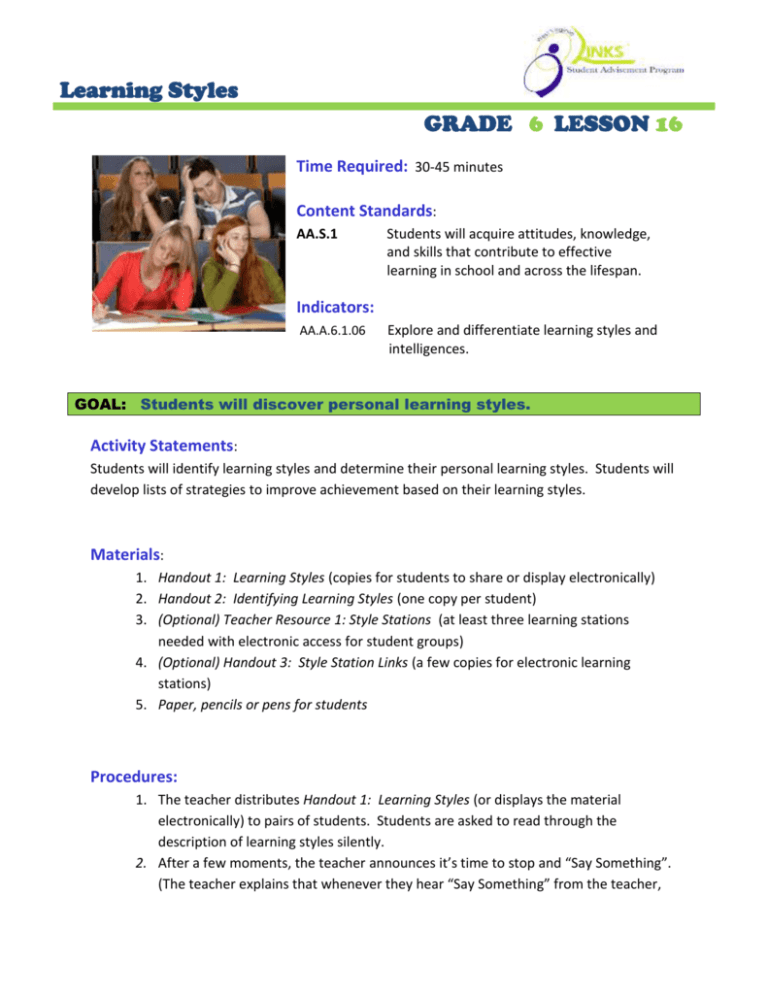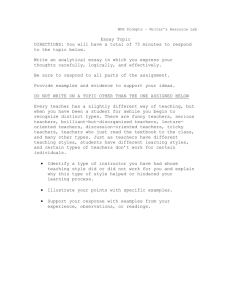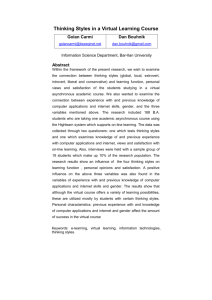Learning Styles
advertisement

Learning Styles GRADE 6 LESSON 16 Time Required: 30-45 minutes Content Standards: AA.S.1 Students will acquire attitudes, knowledge, and skills that contribute to effective learning in school and across the lifespan. Indicators: AA.A.6.1.06 Explore and differentiate learning styles and intelligences. GOAL: Students will discover personal learning styles. Activity Statements: Students will identify learning styles and determine their personal learning styles. Students will develop lists of strategies to improve achievement based on their learning styles. Materials: 1. Handout 1: Learning Styles (copies for students to share or display electronically) 2. Handout 2: Identifying Learning Styles (one copy per student) 3. (Optional) Teacher Resource 1: Style Stations (at least three learning stations needed with electronic access for student groups) 4. (Optional) Handout 3: Style Station Links (a few copies for electronic learning stations) 5. Paper, pencils or pens for students Procedures: 1. The teacher distributes Handout 1: Learning Styles (or displays the material electronically) to pairs of students. Students are asked to read through the description of learning styles silently. 2. After a few moments, the teacher announces it’s time to stop and “Say Something”. (The teacher explains that whenever they hear “Say Something” from the teacher, Learning Styles GRADE 6 LESSON 16 students should stop and take turns so that each person tells his/her partner one important point from the assignment.) 3. The teacher distributes Handout 2: Identifying Learning Styles and explains the instructions for completing the assignment (page 1 of Handout 2). After completing the self-assessment (pages 2 and 3 of Handout 2), students will circle the learning style on page 4 of Handout 2 for which they scored the highest and read that section silently. 4. The teacher may use the instructions from Teacher Resource 1: Style Stations to provide learning stations for students based on their choice of learning style. If electronic learning stations are not available, the teacher may use other materials for student research. Discussion: According to the self-assessment on Handout 2, what is your main learning style? Were you surprised by the results of the self-assessment? Explain. What are the three learning styles? Give an example of a learning tip for each of the learning styles. Learning styles are related to how we prefer to learn, not what we learn. Explain this statement in your own words. How can this information help you do better in school? How can you develop a learning style that may not be your preferred learning style? How might this be useful? Additional Resources: http://www.educationworld.com/a_lesson/03/lp319-01.shtml - student learning-strengths http://www.ldpride.net/learningstyles.MI.htm - learning styles for multiple intelligences http://www.edutopia.org/multiple-intelligences-learning-styles-quiz - learning styles and multiple intelligences http://www.studytechniques.org/learning-styles.html - study techniques http://www.pacareerzone.org/assessment/home.jsf?conversationId=1628396 – career zone http://www.berghuis.co.nz/abiator/lsi/lsiframe.html - learning styles http://www.learning-styles-online.com/inventory/ - learning styles inventories Learning Styles GRADE 6 LESSON 16 http://www4.ncsu.edu/unity/lockers/users/f/felder/public/ILSpage.html - Index of Learning Styles http://people.usd.edu/~bwjames/tut/learning-style/stylest.html - Learning Styles Inventory http://www.nwlink.com/~donclark/hrd/styles.html - Learning Styles and Preferences (teacher resource) http://www.mindtools.com/mnemlsty.html - finding balance in your learning styles http://www.teachervision.fen.com/group-work/cooperative-learning/48547.html - Think, Pair, Share Strategy (teacher resource) http://clte.asu.edu/active/usingtps.pdf - Think, Pair, Share Strategy (teacher resource) Extension Activities: Students may study learning styles independently by searching for additional resources, inventories, and study techniques for their own individual styles. Students may discuss learning styles with other students and/or adults. Students may work on developing the learning styles that are not their first preference. Other activities as assigned by advisor. Activity: Have the student take the Learning Style Inventory in the Learn About Yourself Section Have students record their Learn Style Inventory Results in their Portfolio Have students record their thoughts and plans for incorporating their learning style knowledge in their Journal Developed by: Dr. Penny Fisher, Director, Putnam County Schools (2010)






